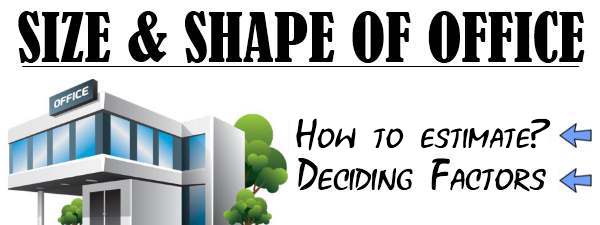Size and Shape of Office | How to estimate | Deciding Factors
Table of Contents
Size and Shape of Office
The size of an office is based on the size of the business organization. If large scale business is carried on, the size of an office is also big and vice versa.

The reason is that the size of a business unit is the main deciding factor for the size of an office. If size of the office is small in relation to the size of the business unit, it may not be able to function efficiently. Therefore, the optimum size of office is required for effective functioning. The shape of office is based on the policy of the top management and the convenience required for employees.
The size and shape of the office building should be conductive to the present requirement as well as for the future expansions. Each worker in the office must be given facilities according to the job performed by him. There is no hard and fast rule with regard to the selection of size and shape of an office building. At the same time, provision of unnecessary space for future needs, which may not be required at all, is not advisable as it will only mean wastage of money.
Special attention may be devoted in deciding the shape of an office. The shape may be square, rectangular, long and narrow or L-shaped. It is advisable to select a square or rectangular space rather than long and narrow space. The reason is that the latter requires much walking back and forth by the office staff and no possibility of optimum utilization of office.
How to estimate the Size of Office?
The size of an office may be estimated in anyone of the following ways.
1. Number of Employees: The number of persons employed may be considered to decide the size of an office. While calculating the number of persons, the inefficient persons may be excluded to get correct idea of the size of an office.
2. Size of Salary Bill: The size of an office is a large one if there is huge amount of salary bill and vice versa. But, when the salary structure is irrational, it may not be an accurate indicator of the size of an office.
3. Investment in Machines and Equipment: The investment in office machines and equipment is the policy of the top management. If an office work is done through mechanization. the size of an office is small and manual work practice is followed to complete office work, the size of an office is large. Therefore, investment in machines and equipment may differ in two offices of almost the same size.
4. Administrative Expenditure: Administrative expenditure refers the amount spent for running the office. The amount is decided and fixed in the annual budget. So, the total administrative expenditure can be considered as an indicator of deciding one size of an office.
Even though, administrative expenditure cannot be a fully reliable indicator. The reason is that some organizations have own office building. For which, there is no need of paying rent and rent is not included in administrative expenditure.
In view of the above discussion, it is advisable to use several indicators simultaneously to obtain an exact idea of the size of an office.
Factors deciding the size of office
The management should take into the consideration of the following factors while determining the size of an office.
1. Office Size of Similar Organization: Size of an office is based on the size of business organization. Hence, a new organization may adopt the office size of an existing organization in the same industry in the same size.
2. Volume of Work: Generally, a high volume of work requires a bigger office and vice versa.
3. Volume of Production and Sales: The sizes of an office vary with the changes in the production and sales of an organization.
4. Design of Layout: The type of layout used in the office also exercises influence on office size.
5. Nature of Work: The nature of work of a manufacturing concern needs a bigger office than trading or service concerns.
6. Systems Design: The office size is determined according to facilities provided and the systematic control exercised on them.
7. Organizational Structure: The size of an office depends on a large extent of the organization structure. The organizational structure may be horizontal or vertical and the office size may have to be designed accordingly.
8. Office Automation: Automation refers to the completion of large volume of office work with the help of machines automatically. For which modern sophisticated equipment and machines have to be applied. Hence, labour savings and time saving appliances determine the size of an office.
